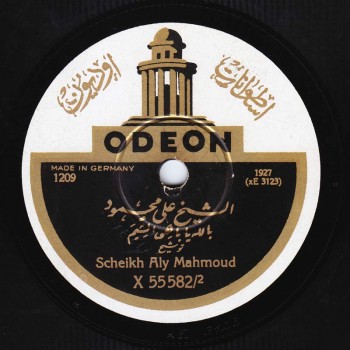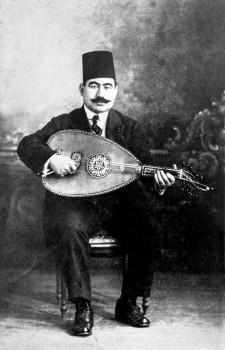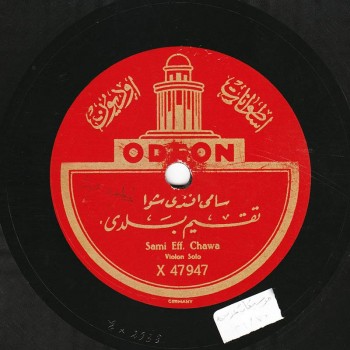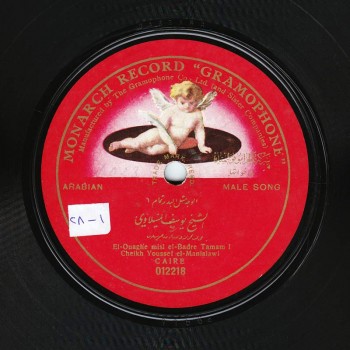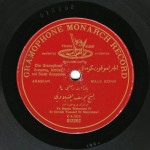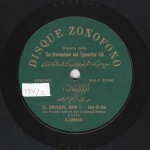The jahārkāh is the fourth maqām as well as the first derived maqām.
It was derived from the rāst discussed previously by altering the sīkāh –that is almost mid-way between the dūkāh and the jahārkāh– that is then replaced by the būslīk often considered as having originated from the jahārkāh.
The jahārkāh maqām is also known as the baladī maqām (popular maqām ) because of its popular aspect especially in the Wajh Baḥrī region in Egypt.
Muṣṭafa Sa‘īd tells us about the jahārkāh maqām:
The jahārkāh –or jirkah– maqām is a popular maqām in essence. It is a rāst whose third and fourth scale steps are close: the fourth is incomplete –decreased– and consequently the third oversteps its position in the rāst.
The jahārkāh has a popular baladī aspect, yet still includes some sobriety unlike the sīkāh. We mentioned previously that mashāyikh are not too keen on the sīkāh because it lacks sobriety.
The jahārkāh maqām is played in all traditions and does not lose its popular cachet in any of them. The popular influence can’t be cancelled in a taqsīm to the jahārkāh for example.
All performers have failed to free it from this influence and to give it a literary classical aspect in their adwār, muwashshaḥāt, and even in their tawāshīḥ. They all had to go back to the popular aspect. I have actually never heard anyone who was able to get rid of the popular aspect. The beauty of the jahārkāh lies in its popular, cantabile, and dulcet nature. No one has ever completed the scales, yet performers like ‘Abd al-Ḥayy and Ṣāliḥ, as well as popular muṭribīn such as Muḥammad al-‘Arabī and others did a lot with the five scales allowed by the popular nature of this maqām. We will be dedicating an episode to a recording titled “Mughram baladī we-mughram rūmī” by Aḥmad Sharīf. Conclusion: the jahārkāh maqām has a popular cachet based on its five scale steps.
The first example we will listen to is a samā‘ī to the jahārkāh maqām, composed by Safar Bēh ‘Alī, performed by Muṣṭafa Bēh Riḍā (qānūn), Zakī ‘Izzat (kamān), Amīn Bēh al-Mahdī (‘ūd), and Maḥmud Raḥmī (percussions). This electric power-printed recording was made by His Master’s Voice –daughter company of Gramophone– around 1927, on one side of a 25cm record order # 7-19750, matrix # BF 2601.
As highlighted earlier, the jahārkāh maqām has a popular cachet. Many music professionals were inspired by it in their taqsīm. They even added a popular facet to some instruments in order to bring more entertainment and emotion to their performance and to the literary “serious” instrument.
One of these samples is by Sāmī Afandī al-Shawwā. Note how Sāmī talks with his violin to the popular instruments: the rabāba (rebab) or the mijwiz (single-reed woodwind). Let us listen to the recording titled “taqsīm baladī” made by Odeon in 1925 on one side of a 27cm record, order # X 47947, matrix # EX 2938.
The old dawr “ ‘Ala rūhī anā el-gānī” is one of the most famous adwār composed to the jahārkāh maqām. It follows the pre-‘Abduh al-Ḥāmūlī/Muḥammad ‘Uthmān pattern and consists in one melody that starts in the madhhab, followed by a tafrīd by the solo performer who may at whim go up, down, or shift.
Let us listen to Ṣalība al-Qaṭrīb accompanied by the Lebanese Radio band in a rare recording of this dawr made in the mid-1950s.
Numerous sub-maqāmāt were derived from the jahārkāh maqām, including the: shōq afzā, basandītah, shōq nama, and many others.
Let us listen to Yūsuf al-Manyalāwī singing dawr “El-wagh mitl el-badr tamām” written by Sheikh Muḥammad al-Darwīsh and composed by ‘Abduh Afandī al-Ḥāmūlī to the shōq nama. The recording was made by Gramophone in 1907 on two sides of a 30cm record. In 2011 on the occasion of the centenary of the death of Sheikh Yūsuf al-Manyalāwī, the AMAR foundation published it again within the Complete Works of Sheikh Yūsuf in a re-mastered recording supported by the period’s sound technology, order # 012218 and 012219, matrix # 1156 C and 1157 C. Sheikh Yūsuf is accompanied by takht Muḥammad Afandī al-‘Aqqād (qānūn), Ibrāhīm Afandī Sahlūn (kamān), ‘Alī Afandī ‘Abduh Ṣāliḥ (nāy), Muḥammad Abū Kāmil al-Raqqāq (percussions), and a biṭāna of munshidīn including most probably ‘Alī Afandī ‘Abd al-Bārī, Ḥassan Yūsuf al-Manyalāwī, and others.
As to inshād, it still carried the jahārkāh maqām’s popular influence. Let us listen to Sheikh ‘Alī Maḥmūd and his biṭāna performing a clear example of this: a jahārkāh maqām dārij titled “Bi-el-llāh yā bāhī el-shiyam”. The recording was made by Odeon around 1926 on one side of a 27cm record, order # X 55582 2, matrix # XE 3123.
We have reached the end of today’s episode of “Nithāmunā al-Mūsīqī”.
We will meet again in a new episode.
- 221 – Zakariyya Ahmed – 12 (1/9/2022)
- 220 – Zakariyya Ahmed – 11 (1/9/2022)
- 219 – Zakariyya Ahmed – 10 (11/25/2021)
- 218 – Zakariyya Ahmed – 9 (10/26/2021)
- 217 – Zakariyya Ahmed – 8 (9/24/2021)
- 216 – Zakariyya Ahmed – 7 (9/4/2021)
- 215 – Zakariyya Ahmed – 6 (8/28/2021)
- 214 – Zakariyya Ahmed – 5 (8/6/2021)
- 213 – Zakariyya Ahmed – 4 (6/26/2021)
- 212 – Zakariyya Ahmed – 3 (5/27/2021)
- 211 – Zakariyya Ahmed – 2 (5/1/2021)
- 210 – Zakariyya Ahmed – 1 (4/28/2021)
- 209 – W-al-Lāhi lā astaṭī‘u ṣaddak 2 (4/6/2017)
- 208 – W-al-Lāhi lā astaṭī‘u ṣaddak 1 (3/30/2017)
- 207 – Bashraf qarah baṭāq 7 (3/23/2017)

